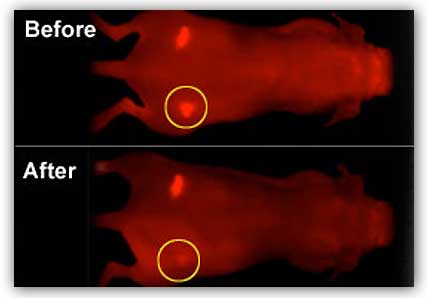|
Researchers have designed a light-based therapy that allows the selective destruction of tumor cells in mice without harming surrounding normal
tissue.

This method of cancer therapy could theoretically work against tumors in humans, such as those of the breast, lung, prostate, as well as cancer cells in the blood such as leukemias, say scientists from the National Cancer Institute (NCI), part of NIH. The study appeared online Nov. 06, 2011, in Nature Medicine.
Current photodynamic therapy is not specific for cancer cells, resulting in damage to surrounding normal tissue. Therefore, the researchers in this study set out to develop a light therapy that could more accurately target cancer cells while sparing a greater number of normal cells.
This new type of treatment, called photoimmunotherapy, or PIT, uses light to rapidly and selectively kill cancer cells.
To create their PIT, the scientists coupled a monoclonal antibody or MAb, which recognizes specific proteins on the surface of cancer cells, with a photosensitizer — a molecule that, when exposed to light of the appropriate wavelength (near-infrared), rapidly damages cells.
The hope was that the combined photosensitizer/MAb would, by delivering the photosensitizer to cancer cells targeted by the MAb, selectively kill those cells after exposure to near-infrared light.
After evaluating a large number of photosensitizers, the scientists found that a near infrared fluorescent dye called IR700 had the most favorable chemical
properties.
The scientists chemically linked IR700 to three different MAbs, including antibodies that target HER2, which is overexpressed by some breast cancers; EGFR, which is overexpressed by some lung, pancreatic, and colon cancers; and PSMA, which is overexpressed by prostate cancers.
The researchers found that when cancer cells bound MAb-IR700 and were exposed to near-infrared light, the targeted cells rapidly died whereas cells lacking the ability to bind the complex were unharmed.
When the complex was tried in mouse models of cancer, even a single dose of near-infrared light resulted in dramatic tumor shrinkage in mice that had been given MAb-IR700. Like visible light, infrared light has a range of wavelengths that range from red light to violet; near-infrared light is closest in wavelength to visible light.
Photoimmunotherapy using MAb-IR700, unlike conventional photosensitizers which can cause damage to healthy tissue, does not appear to harm normal cells. Whereas the light that is required to activate conventional photosensitizers can penetrate through only about 0.8 centimeters of tissue (about a third of an inch), the near-infrared light used to activate IR700 can penetrate tissue to a depth of several centimeters (One centimeter is .39
inch).
The study also found antibody doses required for diagnosis were significantly lower than those required for therapy. Nevertheless, after MAb-IR700 exposure, the targeted tumors decreased in size and eventually disappeared, suggesting a potential means of controlling cancers with far lower doses of MAb than are usually administered to cancer patients, say the scientists. Because the MAb-IR700 compound also emits a small amount of light, it can be used to monitor therapy as
well.
"The ability to join different MAbs to IR700 means that this technique might be used as a non-invasive guide to monitor the results of treatments," said Hisataka Kobayashi, M.D., Ph.D., chief scientist in the Molecular Imaging Program at NCI’s Center for Cancer Research. "Although more testing will be needed, we believe this PIT method has the potential to replace some surgical, radiation, and chemotherapy
treatments."
NCI leads the National Cancer Program and the NIH effort to dramatically reduce the burden of cancer and improve the lives of cancer patients and their families, through research into prevention and cancer biology, the development of new interventions, and the training and mentoring of new researchers.
For more information
National Institutes of Health (NIH)
Reference: M Mitsunaga et al. Cancer cell-selective in vivo near infrared photoimmunotherapy targeting specific membrane molecules. Online Nature Medicine, Nov. 06, 2011,
DOI: 10.1038/nm.2554.
(MDN)
|
![]()